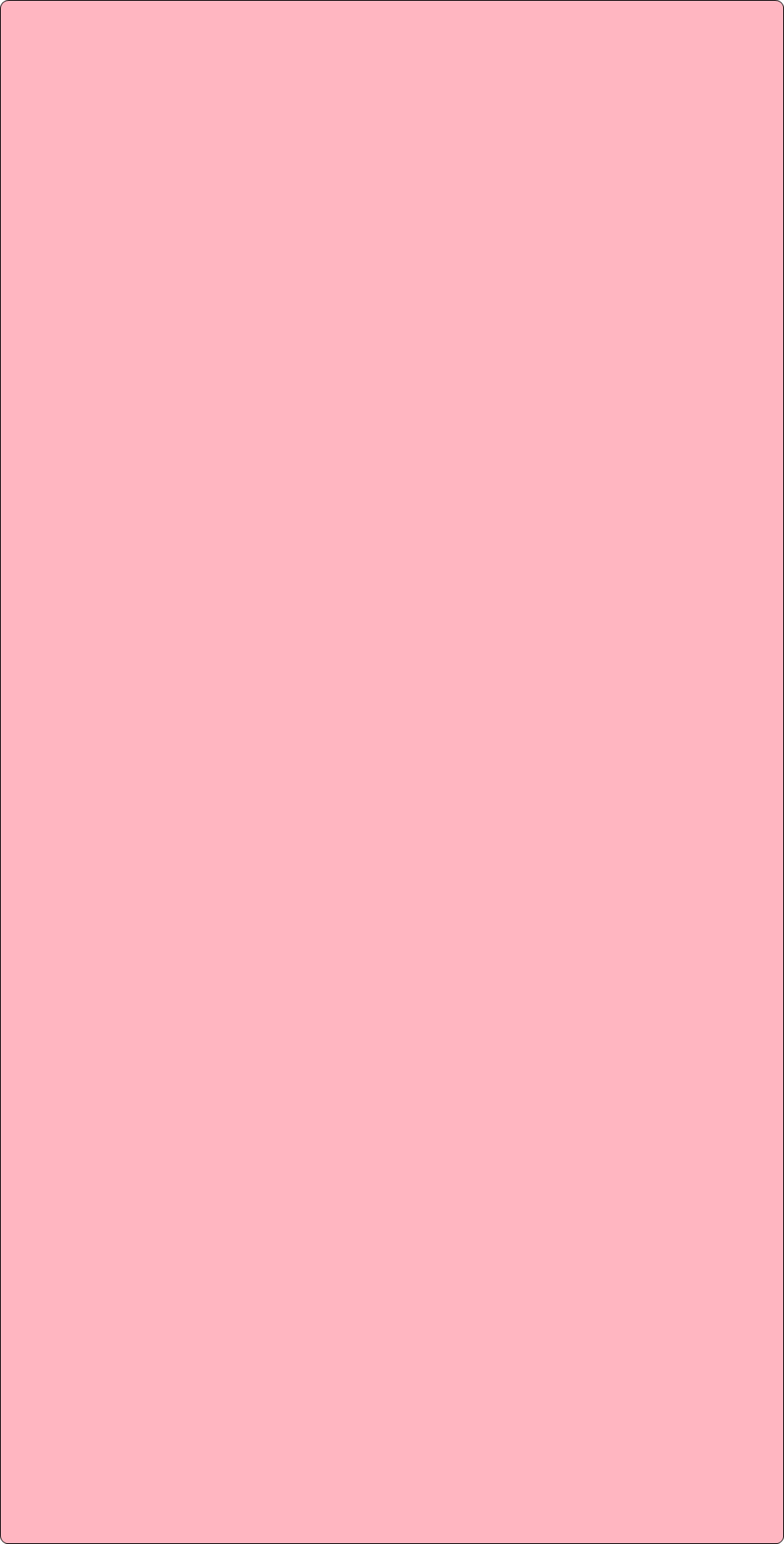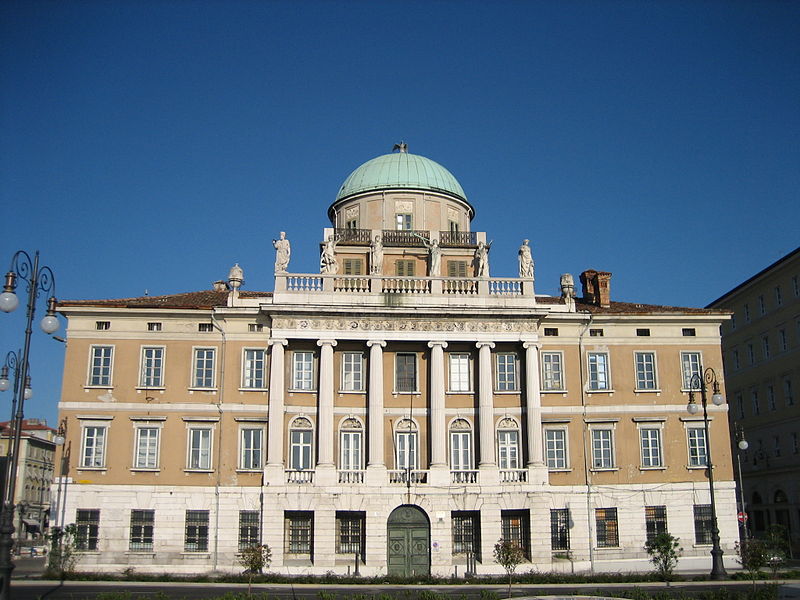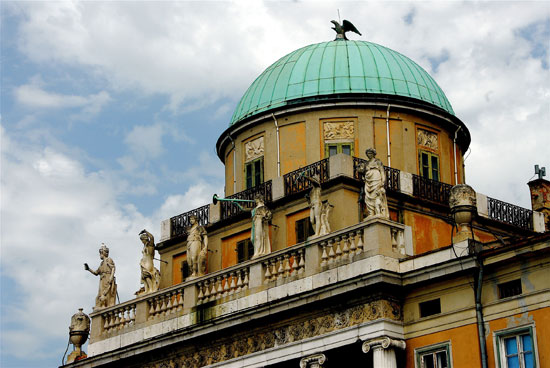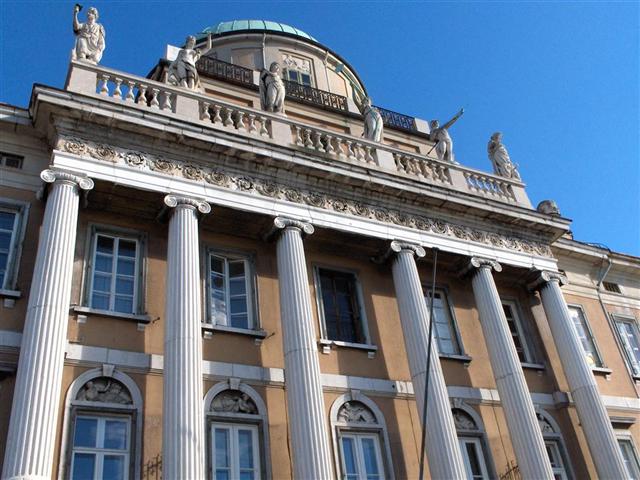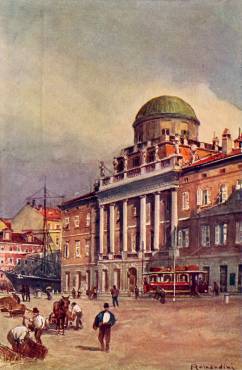Palazzo Carciotti (1798 - 1780)
riva III Novembre 13c
Arch. Matteo Pertsch
The Greek merchant Demetrio Carciotti, who settled in Trieste in 1775, wanted to erect a grandiose palace flanking the Grand Canal. The building permit was given by the Factory Management in 1798, with the recommendation to comply with the fire safety regulations then in force.
For the construction of the palace, Carciotti called the architect Matteo Pertsch to Trieste.
The building, which underwent many changes during construction, which was overseen by Giovanni Righetti, has impressive dimensions: that is, it is 100 meters long and 40 wide. It is in a prominent position, at the beginning of the Grand Canal and clearly visible from the sea.
The building included the owner's home on the main floor facing the sea, sixteen houses on the upper floors and on the ground floor stables, sheds and eighteen warehouses.
The building in 1831 became the first headquarters of Assicurazioni Generali, it was then the headquarters of the Port Authority and Acegas (Municipal Electricity Gas Water Company). Today it is owned by the Municipality which after the restoration will decide for future use.
The main facade uses the same basic scheme that appears later in the Verdi Theater: that is, we are in front of a rusticated base on which giant order columns rest, only in the central part of the facade of the building: here however the base of the columns it is not a patent porch, but is squeezed against the brickwork. In Palazzo Carciotti the scheme is carried out with greater breadth and with more refined and controlled means. The central ashlar portico adheres to the architectural body and acts as a stylobate to the six fluted Ionic columns that harmoniously connect the two upper floors, crowned by a scenographic balustrade adorned with statues. The building is completed by a dome, which rests on a high drum, with a hemispherical dome covered in copper and topped by the Napoleonic eagle.
The side facades are simple, with the smooth ashlar band on the ground floor, punctuated only by the windows and by the architrave in the upper band.
The rear facade is the same as the main one: the same smooth ashlar base in the portico on the ground floor which supports the six fluted Ionic columns, closed by a balustrade, but here it is crowned by four statues and two stone amphorae on the sides. On the entablature appears the writing in bronze letters: DEMETRIO CARCIOTTI MDCCC, that is, the year of the end of the work on that facade.
On the main floor there is a round room punctuated in the perimeter by sixteen columns and adorned with delicate bas-reliefs above the door that deal with Homeric themes, are made by Antonio Bosa and completed by the dignified paintings of Giuseppe Bernardino Bison (1762-1844). The room takes on the elegant appearance of the Empire-style interior. The dome follows the classicistic scheme desired by Pertsch, but extraneous to the tastes of Bison. A certain Scala also appears to have participated in the paintings in the room, author of the "Glory on the chariot of Aurora", depicted in the central circle, the only one in color, albeit of modest construction. In the sails of the dome there are reliefs with scenes from the Iliad, while the decorative plaques below are the work of Bison.
Most probably the sculptures of Palazzo Carciotti were suggested by the client himself, who wanted to be remembered as a merchant and benefactor of the city. Eight of the ten statues that adorn the facade of Carciotti and the four vases are the work of the Bassano sculptor Antonio Bosa (1777-1 845), a spiritual pupil of Antonio Canova; the two statues to the left of the post facade are by Bartolomeo Augustini.
On the main facade the statues represent, from the left: Portenus (the guardian of the Roman port), Thyke (protector of shopkeepers and sailors), Athena (protector of weaving, remember that the owner was a merchant in fabrics), Fama (news dispenser good and bad), Apollo (god of harmony and order), Abundantia (with allusion to the luxury of the merchant who, with risks and work, also benefits the city). The vases are of fine workmanship, soberly decorated, and recall those of the Venetian villas. The lunettes above the windows should also be the work of Bosa, being worked in a rather elegant way; not so the bas-reliefs with putto motif, rather coarse, found on the dome. Del Bosa are also Ercole and Minerva placed in the main entrance dating from around 1804, as is clear from a letter in that year by the same sculptor, which certifies the authorship of these two statues and the bas-reliefs of the round room. According to Bensch they represent the symbols of the protection of the house, they are hieratic and solid figures.
The three female figures at the top of the staircase represent: Painting, Sculpture and Architecture. In them coexist classical tradition and rococo gracefulness; if, in fact, for the two with bare breasts Bosa seems to be inspired by Canova's Hebe of 1796, the one with the peplum recalls a caryatid from the Erechtheion of Athens.

